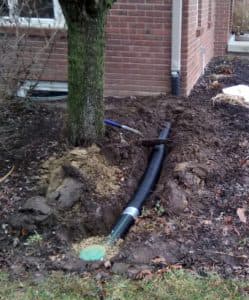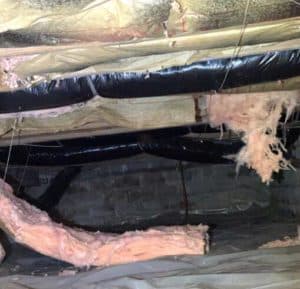
Originally posted 1/4/19, updated 12/27/22
Is one of your New Year’s resolutions to improve your home? Not sure if your home is ready for the harsh conditions of January in the Midwest? There are several things you can do to prepare your house for the weather coming our way!
Acculevel is a family-owned and operated company that specializes in waterproofing and foundation repair. Our home office is in Rossville, Indiana, where we’ve been since our start in 1996. Like you, we’ve endured ice storms, major snowfall, and temperatures in the negative. And since we’re experts in foundation repair, we know how these extreme conditions can damage your home.
In this article, we’re going to give you our top five recommendations to prepare your home for winter- plus some additional resources for you to use!
Regular maintenance and preventive measures are vital to having a solid foundation and a healthy home. A strong and secure foundation is a critical part of having a comfortable home- and it also increases your investment (and your home’s resale value).
Your home’s gutters are little like taxes: cleaning them is tedious, but if you skip doing them you’ll regret it later. Gutters are supposed to collect water and direct it down and away from your home. This helps prevent water from pooling around your foundation, where it can contribute to hydrostatic pressure.
Hydrostatic pressure is a formal way of describing water building up in the soil and pressing against your foundation. It’s one of the primary causes of foundation cracks and water intrusion.
Keeping your gutters free of debris and securely affixed is an inexpensive way to prevent a leaky foundation.
Make sure your downspouts are secured and intact, also. We recommend that gutters release water a minimum of 10 feet away from your home. If yours don’t meet that minimum? We have a blog- with video tutorial- that demonstrates how to make a downspout extension in 4 steps.

This photo was taken by an Acculevel crew member, after installing a downspout extension at a customer’s home.
Acculevel is your foundation expert- not a roofing company- so we have limited information to offer on this one. But we do know that proper insulation in the attic is the number one thing you can do to prevent ice dams from forming. Ice dams build up over the winter, damaging your shingles and creating leaks in your roof. And when those ice dams melt? Because they form over and across your guttering, they don’t melt and drain into your gutters.
This means that melting ice dams contribute to hydrostatic pressure forming around your foundation.

You can see the icicles are forming over the guttering, creating an ice dam.
I know you may think waterproofing isn’t an issue in the winter, but that’s not true. Midwestern winters can have wildly fluctuating temperatures, causing snow to melt and re-freeze multiple times. Snowmelt is another moisture method that contributes to hydrostatic pressure, and it often becomes water intrusion. So don’t ignore waterproofing maintenance in the fall and winter!
Now, if you have waterproofing, you know this consists of a water drainage system and a sump pump. Your sump pump uses a discharge line to remove the water and expel it away from your home. Since your sump pump could be collecting melted ice and snow at any point in the winter, you need that discharge line to be clear and functioning.
A sump pump is an easy thing to test; just pour a gallon of water into the sump pump pit, then follow the discharge line outside to make sure it’s working. Have concerns about your sump pump? Check out our troubleshooting guide. Is he drainage line clogged, or sluggishly draining? This blog walks you through how to prevent your discharge line from freezing.
The entry points of your foundation will vary, depending on your foundation type.
You probably have at least one or two windows built into your basement. These windows should have sturdy and intact wells to shield them against the elements. Window wells often collect dead leaves, grass clippings, and other natural debris. These should be cleared out, usually at the same time gutters are cleaned. Organic material will gradually decay and mold, and you don’t want this developing right next to an access point to your home.
Now, if that window well surrounds an egress window, you should probably have a protective cover installed. This is a safety concern as well as a home protection element. Egress window wells are usually deep and wide, and can be a major hazard if someone misses their footing and falls in. (Most frequent “offenders” are kids and pets who don’t pay attention while running around the yard.)

This photo was taken by an Acculevel crew member, after installing an egress window in a customer’s home.
You may not have an outside entry at all. If you access your crawl space from inside your home, you can skip this step!
However, if your access point is on the exterior of your home, you need to make sure your crawl space has a secure door or Turtl. A missing or damaged door will allow all sorts of unpleasant things to get under your house. You’ll certainly have leaf debris and moisture getting in, but you could also be inviting insects and small animals to shelter in your crawl space.
The air from your crawl space makes its way into your home. Having pests under your home could expose you to all sorts of viruses and bacteria, compromising your home's air quality (and your health). Those intruders can also do significant physical damage to your home: nesting in the fiberglass insulation, chewing on wiring, etc.

This photo was also taken by an Acculevel crew member, this time after installing a steel door and window well for a customer.
If you’re feeling drafts in your basement, or if you have cold floors above your crawl space, you need to review the insulation around your foundation. Fiberglass insulation isn’t the most effective way to insulate a basement, and it’s a terrible way to insulate a crawl space.
Fiberglass insulation is difficult to install properly, and it readily absorbs moisture. This means in a damp environment, it’s going to soak up humidity and become soggy. If it absorbs enough moisture, it will sag, which definitely doesn’t help block drafts. And until it sags, it’s pressed against your home’s wooden flooring structure (joists, beams, subfloor, etc). Do you know what the number one cause of sagging floors is? Yep- it’s moisture.

This photo was taken by an Acculevel project advisor during a free in-home assessment. The fiberglass insulation in this crawl space is damp, molding, and falling on the ground.
Spray foam insulation is a far superior product. Not only does spray foam repel moisture, but it adheres to any surface you spray it on. This means it stays in place, fills every nook and cranny, and thoroughly blocks drafts.
Do you feel like you need a thorough evaluation of your home, but you’re not sure what to review? We have a DIY guide to help you with that! Our home inspection checklist for your foundation is free and available to any homeowner who understands the value of preventative maintenance. This guide walks you through a detailed review of your home, inside and out, explaining what you’re looking for, and what you should be concerned about finding.
If you’re not the DIY type, but you want a thorough check-up of your home? Sign up for Acculevel’s Home Inspection Program! One of our service technicians will come to your home and perform a thorough evaluation for you. Once completed, they’ll sit down and review with you any symptoms or issues they find, and if needed, a follow-up with one of our project advisors. Click here to complete our online scheduling form.
You can also research any potential concerns in our Foundation Repair Guide. This is another resource we provide at no charge to all homeowners. In it, we explore hydrostatic pressure, types of cracks you may see in your foundation, signs of settling, repair methods, costs and why we recommend the options we provide.
[DISPLAY_ULTIMATE_SOCIAL_ICONS]